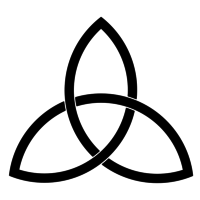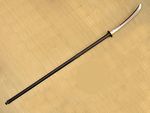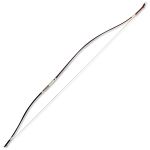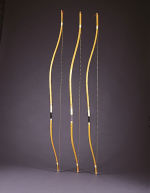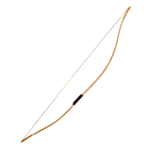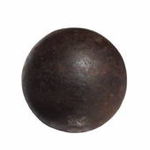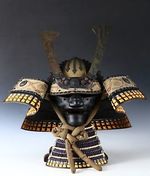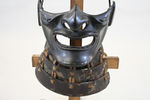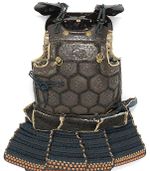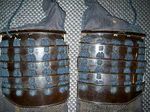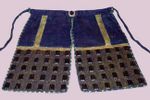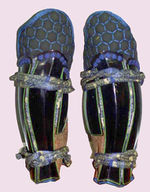Military of Trukya
|
The Mon of the Sendo Clan | |
|
The Mon of the Navy of the Mujihina Clan | |
| Information | |
|---|---|
| Members of Forces | 250,000 |
| Branches | Army and Navy |
| Military Age | Average of 21 |
| Fit for Service | 10,000,000 between persons between the age of 21 and 45 |
| Head of Command | |
| National Army | Commander of the Armed Forces |
| Trukyan Clans | Daimyo |
| Budget | |
| National Army | 30,000,000 |
| Trukyan Clans | 300,000,000 |
The Trukyan Military is a term that applies to the armies of both the Trukyan National Army and the armies of the Trukyan Clans. The Trukyan National Army consists of Armies that are loyal to the current government of Trukya, while Armies of Trukyan Clans refers to Armies that are loyal to the Daimyo of the clan that they are in. Most of Trukya's armies use the same weapons and equipment, due to trade and resource restrictions.
Contents
Different Armies of Trukya
The National Army
The National army is the army that serves underneath the current government within Trukya. Currently, it is the Trukyan Republic underneath Alexei Nakashima. Because of the governments intense prominence within the country, there are some clans who provide their forces to the rest of the National Armies forces. Due to increased power in Clans and deceased power in the Government, over 59% of the National Army is provided by Daimyos in support of the current government. The National Army resides within the city of Chang'li, and has numerous bases within 10-20 miles of Chang'li. Beyond 10-20 miles however, the National Army has almost no influence over the rest of Trukya. The National Army is outnumbered almost 10-1 by the Trukyan Clans, with membership only being at about 20,000 personnel.
The Trukyan Clan Armies
The Trukyan Clan Armies are not a singular army under one ruler, but rather a term for the armies all over Turkya ruled over by different and often hostile daimyos. Trukyan Clan Armies tend to stay within their own lands, and have for the past 200 years. A daimyo will often use his army to suppress rebellions or other things within the province due to small opportunity for military expeditions outside of their own borders. Although some daimyos are enemies, Trukyan Clan Armies have seen their most fighting taking place while suppressing rebellions for other daimyos, or simply travelling to give homage to Alexei Nakashima. Most Trukyan Clan Armies have never been into an actual war not against their own people. Since Trukyan Armies have never stepped outside of Trukya, most of the tactics developed are solely Trukyan. This is both an advantage and a disadvantage as Trukyan Armies tactics can not be predicted, but their tactics are also severely outdated to tactics of the modern world. The amount of personnel within the Armies of various Daimyos in Trukya is numbered at 230,000.
Trukyan Melee Weapons
Melee weapons are used in infantry to infantry battle within Trukya. Better quality Melee weapons are forged and made in order for infantry to gain an upper hand in hostilities. This arms race of sorts has allowed for very specific and very specialized weapons to be produced in Trukya. A list of such weapons with pictures and information can be found below. Most weapons of Trukya are made of the following materials, steel, iron, and wood. Because of the significance of some melee weapons to Trukyan culture, they have become items of ceremony.
| Name | Image | Description | Materials |
|---|---|---|---|
| Yari | The Yari is a spear shaped weapon used very commonly in Trukyan warfare. The Yari consists of a wooden shaft with a sharp bladed point at the tip. A Yari is carried by both expert warrior and common Ashigaru alike. Yari are highly effective against cavalry charges, and can stop even expert horsemen in their tracks. Yari can be used against infantry, artillery, and cavalry with good results. Because of the Yari's prime role in Trukyan warfare, it is a very important weapon. | Wood, iron, and steel | |
| Katana | The Katana is a sword used by well trained infantry. The Katana, unlike the Yari, takes years of training to master. A well made Katana will only be given to the most able and well trained of warriors. Katanas are made of steel and have a slight curve to their blade. The Katana has a longer handle than usual to allow for two handed wielding. A Katana is traditionally worn at the hip. The position of the sheath of the katana allows for both the draw and the strike to occur in one movement. | Steel | |
| Naginata | The Naginata is one of the most used weapons in Trukyan battles. The Naginata is a long wooden pole with a sharp blade attached to the end. The length of the pole is around 240 cm, with a blade height of 60 cm. The blade has a slight curve to it, and is made of steel. Naginata are useful against infantry, where their long reach can allow for them to swing at enemy's unprotected areas from a safe distance. The Naginata's long reach is part of the reason in the development of better armour to protect against Naginata blows. There are two kinds of Naginata, the ko-naginata and the o-naginata. The ko-naginata is a standard size Naginata and is quite heavy to allow for an increased fighting efficiency. Because of the ko-naginata's requirement of upper body strength, it is strictly given to trained warriors. The o-naginata is much lighter and is what is given to peasants. | Wood, steel |
Ranged Weapons of Trukya
Ranged weapons are used in Trukya to cut down enemies before infantry can meet in battle. These include ranged weapons that do not require gunpowder to operate. These types of weapons are powered by the drawing back of a string to release a projectile.
Firearms are the most common ranged weapons in Trukya. 1/3 Trukyan soldiers have a firearm as their main weapon in battle. Even though firearms are very lethal and dangerous, most gun soldiers will also carry a sword in case of an infantry charge. Only the best of Trukya is trusted with guns as they are very dangerous in the wrong hands. Fuel for guns can not get wet, and it is extremely difficult to fire guns at night with accuracy.
| Name | Image | Description | Materials | |||
|---|---|---|---|---|---|---|
| Bows | ||||||
| Yumi | The Yumi is a very widely used weapon in battles in Trukya. A longbow is one of the most effective weapons at fighting the enemy from a distance. Arrows in longbows can be modified with special arrows, such as weighted arrows to increase armour penetration, barbed arrows to do more damage to lightly armoured targets, and arrows set on fire to burn the enemy. Most well trained soldiers carry a bow on their back even if they specialize in swordsmanship. | Wood | ||||
| Daikyu | The Daikyu is a longer version of the Yami. It is used by soldiers who specialize in bows rather than use them as a second weapon. Since they are much heavier, Daikyu soldiers are kept farther back where they can not be harmed by the enemy as easily. The daikyu is capable of firing much heavier arrows than the Yumi, but it is also requires more strength to operate. As such, it is only given to the strongest and most trained of soldiers. | Wood | ||||
| Hankyu | The hankyu is a shorter version of the Yami. It is used by non trained soldiers or peasants due to its light weight. Since they are much lighter, hankyu soldiers are kept in the front where they can strike and run back to friendly lines easily. The hankyu is only capable of firing much lighter arrows than the Yumi. | Wood | ||||
| Firearms | ||||||
| Matchlock | The matchlock is the most important weapon in Trukyan warfare. This weapons are some of the most effective, and have the greatest killing power of any weapon of Trukya. The matchlock is loaded by stamping a ball made of iron into the bottom of the barrel, as well as gunpowder, and firing it. The shot of a matchlock can cut through almost all traditional armour. A length of rope can be tied to rifles and the user to maintain the perfect angle for firing at night, when it is difficult to see. | Wood, iron | ||||
| Ammunition | ||||||
| Iron ball | The iron ball is the main ammunition used in a Trukyan matchlock. An iron ball is put into the gun by pushing it into the barrel with a special tool. Because of the iron ball's usefulness, it is the main ammunition produced within Trukya. | iron | ||||
Armour worn in Trukya
Trukyan armour can be split into main parts. These parts are the dou, the kabuto, and the haidate. Together these pieces help to protect Trukyan warriors against enemy blows and fighting styles. Trukyan armour can be worn at ceremonies of importance, such as the visit to the capital that every Daimyo must do every year. There is little difference between the armour of a samurai and the armour of a Daimyo in battle. Both wear similar types of armour, with the only difference being colour or type of material used in the making.
| Name | Image | Description |
|---|---|---|
| Kabuto | The Kabuto is the helmet of standard Trukyan armour. It is useful to protect the wearer against soft blows to the head. | |
| Mengu | The Mengu is one of the most unique pieces of Trukyan armour. It is more cultural than protective. It shows how war has evolved into an art within Trukya due to decades of internal conflict. The Mengu is designed to strike fear into the opponent by making the face seem much more terrifying than it actually is. | |
| Dou | The Dou is the main part of armour. The dou is the chest armour in a Trukyan set of armour, and can protect against blunt sword blows and weak arrows. | |
| Kusazuri | The Kusazuri is one of the pieces of armour that makes up the traditional Trukyan armour set. It is used to protect the lower legs from soft blows. | |
| Sode | The Sode is one of the pieces of armour that makes up the traditional Trukyan armour set. It is worn on the shoulders to protect from blows to the shoulders. | |
| Kote | The Kote is one of the pieces of armour that makes up the traditional Trukyan armour set. The Kote is worn on the arms and also protects the hands. The Kote can also protect one from cutting themselves on their own sword while drawing. | |
| Haidate | The Haidate is one of the pieces of armour that makes up the traditional Trukyan armour set. It is worn on the thighs to protect from blows and attacks to the wearers thigh region. | |
| Suneate | The Suneate is one of the pieces of armour that makes up the traditional Trukyan armour set. It is worn on the shins to protect them from blows to the legs and shin. |
Trukyan navies have always been a key part of warfare in Trukya, due to the country being totally surrounded by water. Boats are able to transport armies much more quickly than walking by foot, but such armies must be protected. Tactics in Trukyan Navy battles have evolved around the quick boarding and surrendering of enemy ships. Because army troops are usually kept in un-armed ships due to space reasons, the capture of all armed ships will usually lead to the surrender of the other vessels. These quick tactics have led to many inventions, such as burning arrows to light ships ablaze, and special grappling hooks to pull ships within boarding range. Generals will often use separate ships from their standard ships farther away from the battle.
A list of Trukyan ships in warfare can be found below.
| Name | Image | Description | Materials | Weaponry |
|---|---|---|---|---|
| Kobaya | Kobaya ships are fast moving, light weight ships that can quickly board enemy ships that cannot out maneuver it. | Wood | Armed with bows and swords. Bow soldiers will fire upon enemy ships to whittle down their numbers, while swordsmen will jump into the enemy ship upon boarding. Arrows from bows can be set on fire to burn enemy ships without a need to board them | |
| Atakebune | Atakebune ships are large, menacing ships used to attack much smaller ships like the Kobaya. Their high walls and deadly weapons make them difficult to board by smaller ships. Atakebune can be covered in iron plates to deflect fire arrows, and are often armed with arquebuses. | Wood, iron | Armed with gunmen and in rare case with cannons. Swordsmen are also kept on board in rare cases of boarding. |
